Fuel for Thoughts: Preventing Night Terrors
/For years, I had a consistent dream of a bear chasing me. I would wake with my heart racing. I didn’t want to go back to sleep for fear of the bear returning.
How do I fix a problem when I am not even conscious for the event? I started to look for patterns.
I noticed that when I went out with friends and had a drink with dinner, the bear would predictably visit. I noticed that when I had a late dinner with lots of protein and no alcohol, the bear was absent. I moved into a new apartment in the summer and it was hot, so I left the bedroom door open for a cross breeze. No bear. It cooled down and I closed the bedroom door while I slept…bear. Open door, less likely bear. I started a list of what seemed to make a difference. Open door, protein at night, limit alcohol at night: the bear dream was more manageable.
I started seeing a therapist to address some anxiety about being dyslexic and in medical school. When my therapist showed me how turn into my anxiety instead of trying to ignore it or avoid it, my dream changed. One night, instead of running from the bear, I turned to face it and said “What?!” The bear just stopped and sat down in front of me. I had a sense that I had found a new best friend. Now, I can trust my anxiety to tell me when something is off, and I can look with curiosity until I understand my discomfort.
Later as I started to study the physiology of mental health and how the brain works, I could see why my observations helped. Not getting random hits of adrenaline due to dropping blood glucose from alcohol or not eating protein is helpful.
We all have ancient brains that will scan our environment for safety and make sure we are not being approach by lions (or bears). We all need to figure out what our bodies and brains need to feel safe., especially while asleep. Nightmares and night waking are a chance to listen deeply for what we need, observe our patterns, and do experiments to learn more about what the body and brain need. Please read the Short Cuts post for more ideas about how to improve sleep.
























